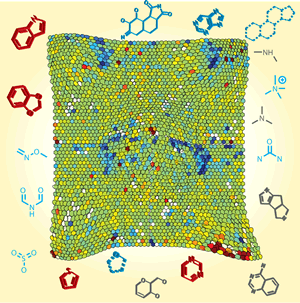Last updated: November 22, 2013
NHGRI Researchers Create New Database of Drug-Metabolizing Enzymes
NHGRI Researchers Create New Database of Drug-Metabolizing Enzymes
October 2009
 |
In an advance that should help speed drug discovery, researchers from the National Institutes of Health Chemical Genomics Center (NCGC) and Trinity College, Dublin, Ireland, have generated the most comprehensive analysis to date of the CYP activity of thousands of drugs and possible drug candidates. Their study is published in the November 2009 issue of Nature Biotechnology.
CYPs, which come in 57 varieties, metabolize approximately two-thirds of all drugs. However, just five of the CYPs handle 80 percent of these drugs. So, researchers set out to profile the interactions between these five CYPs and the libraries of known drugs, along with several large libraries of chemical compounds, called small molecules, being screened for their potential as possible drugs.
"This database of drug metabolizing enzymes will improve current models for predicting CYP-drug reactions and will be a resource for future testing in early phase drug discovery efforts," said the study's senior author Doug Auld, Ph.D., who is the group leader for Genomic Assay Technologies at NCGC, which is administered by the National Human Genome Research Institute (NHGRI).
Henrike Veith, B.S, the study's lead author and an NCGC research associate, added, "This database is the largest publicly available resource of its kind."
To conduct their study, the researchers used an approach developed at NCGC known as quantitative high-throughput screening (qHTS). This approach, which rapidly profiles compounds over a wide range of concentrations, is useful for generating large-scale bioactivity profiles of important gene families and for enabling the identification of chemical probes for use in biomedical research.
The researchers used qHTS to characterize CYP reactions in thousands of drugs and chemical compounds being screened in drug discovery efforts. Past studies have only been able to address a few hundred compounds. In contrast, the NCGC study surveyed more than 17,000 compounds - each at seven or more different concentrations - against the five key metabolizing enzymes.
"This research highlights our center's unique capabilities," said NCGC Director Christopher P. Austin, M.D., who is a co-author of the study. "Our powerful combination of creative science and state-of-the-art technologies has allowed us to address a critical unsolved issue in the early phase of drug discovery."
"It is only through collaborative 'big science' of this type and scale that we can really interrogate those molecular factors that are linked to CYP metabolism and early drug failures." added David Lloyd, Ph.D., Head of the Molecular Design Group in the School of Biochemistry & Immunology, Trinity college Dublin, who led the collaboration on the Irish side.
The new data on CYP bioactivity is available to the worldwide research community through the free PubChem database (PubChem AID: 1851), which is managed by the National Library of Medicine.
